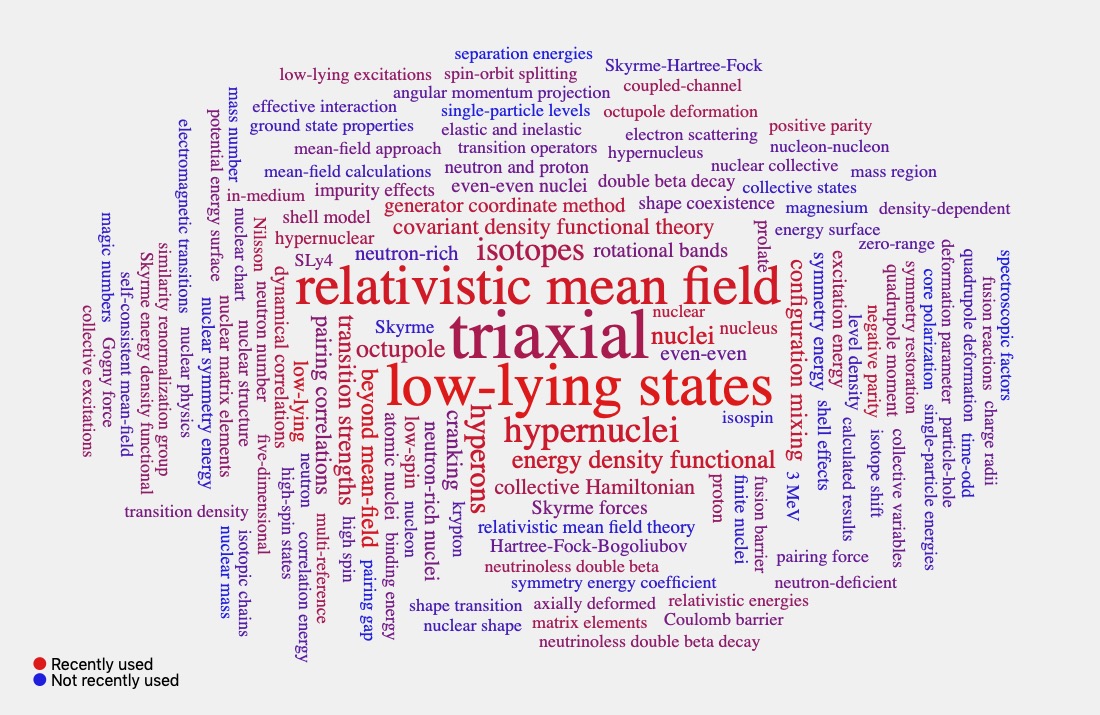Nuclear Physics
The main subject of low-energy nuclear physics is atomic nuclei, composed of two types of nucleons (neutrons and protons). The dynamics of nucleons are fundamentally described by Quantum Chromodynamics (QCD) in terms of quarks and gluons. The goal of low-energy nuclear physicists is to understand the structure and dynamics of atomic nuclei in a fundamental way. Achieving it is difficult, however, because the strong interaction cannot be simply treated in perturbation theory. Presently, low-energy nuclear theorists can be classified into two groups. One focuses on the precise description of nuclear structure properties and reaction rates with phenomenological models, including configuration-interaction shell models, energy density functional methods and various macroscopic collective models. The approach has been successful. Nuclear masses are described with a precision of a few hundred keV. The gamma-ray energy from the de-excitation of nuclear collective levels can be described with keV precision. The second group is devoted to the ab initio description of atomic nuclei. Instead of using the quarks and gluons as degrees of freedom, one starts from nuclear interactions that are derived from QCD-inspired Chiral Effective Field Theory (EFT), which provides a constructive framework and organizational hierarchy for NN, 3N, and higher many-nucleon. Thanks to the Similarity Renormalization Group (SRG) and other modern renormalization group techniques, one is able to decouple the low- and high-momentum physics and obtain low-momentum perturbative NN+3N interactions. These interactions have been used together with a variety of many-body approaches, including Lattice method, Greens Function Monte Carlo, no-core shell-model, Couple-Cluster (CC), and the In-medium Similarity Renormalization Group (ImSRG). Computational power currently limits most of the ab initio studies to light nuclear systems. The ImSRG approach stands out as a promising method for medium-heavy and heavy nuclei in the near future. In this method, the Hamiltonian is normal-ordered with respect to a reference state via the generalized normal-ordering developed by Kutzelnigg and Mukherjee, and plugged into an operator flow equation associated with a continuous unitary transformation. With a suitable choice of flow generator, the transformation decouples the ground state of the Hamiltonian from excitations as the flow parameter evolves to a large value. Low-energy excited states can be studied with equation of motion techniques. At present, the ImSRG method is mainly limited to spherical nuclei and underestimates collectivity in more complicated nuclei. One has to extend the method further to make it applicable to deformed and transition nuclei. One of the most promising ideas is to generalize the reference state from a spherical Hartree-Fock state to a multi-reference state from a generator coordinate (GCM) calculation.
Highlights of my researches

My research focuses on developing theoretical models and large-scale computational codes for atomic nuclei based on either nuclear effective interactions/energy density functionals (EDFs) or modern interactions from chiral effective field theory (EFT), with particular interests on atomic nuclei far from β -stability line, fundamental symmetries and neutrino properties, stellar nucleosynthesis and neutron stars, and machine learning in nuclear physics.
Multi-reference density functional theories for nuclear structure and dynamics
“Beyond-mean-field study of elastic and inelastic electron scattering off nuclei” , J.M. Yao et al., Phys. Rev. C 91, 024301 (2015), selected as 2016 APS Journals Catalog
Double beta decay
What's neutrinoless double beta decay? [ Youtube by Wick Haxton]
Topical Collaboration on Nuclear Theory for Double Beta Decay and Fundamental Symmetries
Advances in modeling nuclear matrix elements of neutrinoless double beta decay, J. M. Yao, arXiv:2008.13249 [nucl-th] (invited contribution to News and Views in Science Bulletin)
Ab Initio Treatment of Collective Correlations and the Neutrinoless Double Beta Decay of
48Ca, J. M. Yao, B. Bally, J. Engel, R. Wirth, T. R. Rodríguez, and H. Hergert, Phys. Rev. Lett. 124, 232501 (2020). see [highlight], see FRIB news
or news on Phys.org
or news on ScienceDaily
Relativistic description of nuclear matrix elements in neutrinoless double-beta decay, L. S. Song, J. M. Yao, P. Ring, and J. Meng,
Phys. Rev. C 90, 054309 (2015), selected as Editors' suggestion.
Strangeness physics and neutron stars
Relativistic mean-field and beyond approaches for deformed hypernuclei , J. M. Yao, H. Mei, K. Hagino, T. Motoba, AIP Conference Proceedings 2130 (1), 020008 (2019). Plenary talk on The 13th International Conference on Hypernuclear and Strange Particle Physics.
Multi-reference in-medium similarity renormalization group for deformed nuclei
SRG evolution of NN interaction
Decoupling ground-state with (IM)SRG evolution
Role of three-body irreducible density in the IMSRG
Two-body transition matrix elements (by Jon Engel)
Agenda
Multi-reference IMSRG for nuclear collective excitations and neutrinoless double beta decay,
NUCLEI Collaboration meeting (virtual), June 9, 2020.
Recent presentations
Neutrinoless Double Beta Decay in the in-medium GCM (pdf), the Topical Collaboration meeting on Neutrinoless Double Beta Decay, May 28, 2020
Ab initio treatment of collective correlations in neutrinoless double beta decay (pdf) Progress in Ab Initio Techniques in Nuclear Physics , TRIUMF on March 3-6, 2020
Ab initio calculation of deformed nuclei with in-medium generator coordinate method (pdf) "the 3rd Conference on "Microscopic Approaches to Nuclear Structure and Reactions" in honor of the late Daniel Gogny, Livermore, November 12-15, 2019
Ab initio Calculation of Nuclear Matrix Elements of Neutrinoless Double Beta Decay with the IMSRG+GCM approach
(pdf), DBD Collaboration meeting, UNC at Chapel Hill, Sep. 06, 2019
Ab initio calculation of deformed nuclei and the nuclear
matrix elements of neutrinoless double beta decay with multi-reference in-medium similarity renormalization group
(pdf) Nuclear Seminar at Peking University, Beijing, Aug 15, 2019.
Ab initio calculation of deformed nuclei and nuclear matrix elements for neutrinoless double beta decay (pdf) INT Program INT-19-2a, Nuclear Structure at the Crossroads , July 1 - August 2, 2019.
Progress in IMSRG+GCM calculations for deformed nuclei,
The 2019 NUCLEI Collaboration meeting, May 22 to 24 in Santa Fe, NM
Multi-Reference IMSRG for Deformed Nuclei (pdf) on The workshop on Progress in Ab Initio Techniques in Nuclear Physics, TRIUMF, Vancouver, Canada, Feb 26 - March 1, 2019.
GCM-based IMSRG and BB decay (pdf) on the DBD Collaboration Meeting at Lawrence Berkeley National Laboraotory, 7-8 September, 2018.
Beyond relativistic mean-field approaches to deformed hypernuclei (pdf)
on The 13th International Conference on Hypernuclear and Strange Particle Physics,
Portsmouth, VA, June 24-29, 2018
Journals
arXiv.org
Physical Review Letters
Physical Review C
My Publications ( pdf )
Preprints on arXiv.org
Inspirehep
Publons
Google Scholar
ORC ID, list of pubs
Web of Science
References
on Neutrino Physics and Astrophysics
Experiments on Neutrinoless Double-Beta Decay
NMEs for Neutrinoless Double-Beta Decay
Grants
Low-lying collective excitations of hypernuclei with microscopic particle-rotor model
NSFC
Packages
SCCM
CPC Program Library
Papers in Dropbox
Compiled by Heiko
Preprint
Related talks
Nuclear Structure at the Crossroads
New applications of the renormalization group
method in nuclear, particle and condensed matter physics (INT workshop)
References
In-Medium Similarity Renormalization Group Approach to the Nuclear Many-Body Problem
Relativistic Density Functional For Nuclear Structure
Symmetry restoration in mean-field approaches
Single-reference and multi-reference formulations
The Coupled Cluster Method (Thomas Papenbrock)
GCM-DFT for excited-state energies of atoms and ions
Simple DMRG
Boulder School for Condensed Matter and Materials Physics(DMRG)
INT talks
see all talks in INT workshops
Nuclear database
Nuclear Levels and Gammas Transition Properties
The NUBASE2016 evaluation of nuclear properties, G. Audi et al., Chinese Physics C Vol. 41, No. 3 (2017) 030001
electronic Books
theoretical-physics

